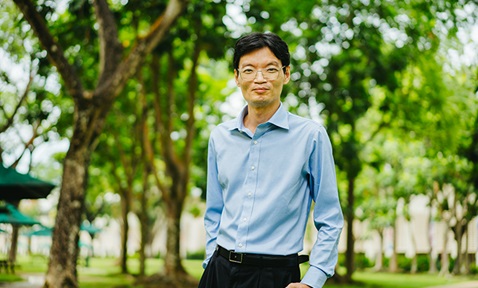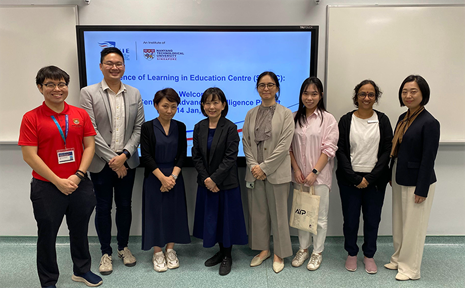New tool makes reading online articles Simpler for students
SINGAPORE - As a secondary school teacher, Mr Noah Zhang found it could be difficult to find suitable online articles that could serve as reading material for students, as many were pitched at adults.
Some students – especially those who required more literacy support – would often have to turn to their teachers to help simplify the articles for them, he said.
Mr Zhang raised this problem in January during a hackathon organised by Open Government Products, an independent division of the Government Technology Agency (GovTech).
GovTech deputy chief executive Chang Sau Sheong told The Straits Times that he was intrigued by the problem posed by Mr Zhang, who is now serving a stint in the Ministry of Education’s (MOE) Information Technology Division as a consultant.
“I reached out to Noah, and then we started a conversation on the problem, which is, how do you help students be able to read and understand better the things that they read?” said Mr Chang.
It was this concern that led to the development of Simpler, an artificial intelligence (AI) tool to encourage students to read more by simplifying difficult words and sentences online.
The Chrome browser extension rephrases sentences and breaks them down into shorter fragments to allow for easier reading.
By just highlighting words on a webpage, Simpler is able to display different versions of words and sentences aligned with students’ preferred reading levels, enabling them to more easily understand online content.
For example, Simpler could simplify the following sentence – from an article on the National Library Board’s website – in a number of ways. “The spice trade brought Arab traders to South-east Asia, which led to the spread of Arabic cuisine to Indonesia, and eventually to Malaya.”
For those with more reading difficulties, the sentence could read: “Traders from Arabia came to South-east Asia. They traded spices. They also brought their food. This food spread to Indonesia. Later, it spread to Malaya.”
For others with higher reading fluency, the sentence could be simplified as: “Arab traders came to South-east Asia because of the spice trade. They brought Arabic cuisine with them. This cuisine spread to Indonesia. Later, it also reached Malaya.”
Mr Chang said he came up with the basic framework of what would become Simpler in one night, later developing it further based on discussions with Mr Zhang.
Now, a team from MOE’s Information Technology Division is working to enhance the tool.
Using GPT-4o as its large language model, Simpler was prominently featured as a project under Singapore’s refreshed Smart Nation 2.0 strategy, announced on Oct 1 by Prime Minister Lawrence Wong.
The plan aims to equip people here with skills to thrive in the digital economy, foster a community spirit through digital inclusion, and build online safety and trust.
Mr Zhang noted that while generative AI tools such as ChatGPT can perform similar tasks, the process would be much more complicated as students would have to copy and paste sentences and write appropriate prompts in order to get the desired results.
Simpler also considers the Lexile framework – an educational tool that helps measure reading levels – when rewriting texts to improve accessibility.
MOE said it received positive feedback on Simpler from teachers and students involved in a trial that began in June, which included 134 students from Admiralty Secondary School and NorthLight School, a vocational school for students who are less academically inclined.
Ms Yeo Xin Yi, an English teacher at NorthLight, said the tool was effective in helping her students, who require greater reading support, understand text by breaking up sentences into smaller chunks.
English teacher Yeo Xin Yi said the tool was effective in helping her students, who require greater reading support, understand text by breaking up sentences into smaller chunks.
“They don’t need to read the whole text at one shot, which is very daunting to them,” she said, noting it could also help those with issues such as dyslexia.
To avoid stigmatising students based on their reading ability, Simpler identifies different reading levels by five different colours instead of letters or numbers, which could imply an assigned value.
To test Simpler, The Straits Times ran some of the newspaper’s own content through the tool, whose use is currently limited to those in the trial.
The following paragraph – from a September article on a six-day disruption on the East-West MRT Line that month – was used as an example: “A defective component of the train’s wheel set, known as an axle box, dropped onto the tracks near Dover station while the train was returning to Ulu Pandan Depot, which is between Clementi and Jurong East stations. The axle box was on the third carriage of the six-carriage train, which has been in service for more than 35 years.”
The result of using the blue or second-most simplified option: “A part of the train broke. This part is called an axle box. It fell on the tracks near Dover station. The train was going back to the depot. The depot is between Clementi and Jurong East stations. The broken axle box was on the third carriage. The train has six carriages. The train has been in use for more than 35 years.”
MOE said it will continue to enhance Simpler and expand it to more schools that require literacy support after the current trial.
Singapore has been pushing for greater adoption of artificial intelligence in education.
Earlier in October, PM Wong announced that from 2025, primary and secondary schools will roll out new AI For Fun coding modules to allow children to tinker with technology incorporating AI, as part of the country’s refreshed Smart Nation initiative.
Read the original article here.
Source: The Straits Times © SPH Media Limited. Permission required for reproduction.





